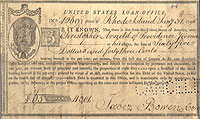Our Heritage
"The United States debt, foreign and domestic, was the price of liberty. The faith of America has been repeatedly pledged for it... Among ourselves, the most enlightened friends of good government are those whose expectations of prompt payment are the highest. To justify and preserve their confidence; to promote the increasing respectability of the American name; to answer the calls of justice; to restore landed property to its due value; to furnish new resources, both to agriculture and commerce; to cement more closely the Union of the States; to add to their security against foreign attack; to establish public order on the basis of an upright and liberal policy; these are the great and invaluable ends to be secured by a proper and adequate provision, at the present period, for the support of public credit."
Alexander Hamilton, 1790, First Report on the Public Credit
Public Debt In America

1798 Bond
Public debt is a fact of life. The U.S. has had debt since its inception. Our records show that debts incurred during the American Revolutionary War amounted to $75,463,476.52 by January 1, 1791. Over the following 45 years, the debt grew.
Notably, the public debt actually shrank to zero by January 1835, under President Andrew Jackson. But soon after, it quickly grew into the millions again.
The American Civil War resulted in dramatic debt growth. The debt was just $65 million in 1860, but passed $1 billion in 1863 and had reached $2.7 billion following the war. The debt grew steadily into the Twentieth Century and was roughly $22 billion as the country paid for involvement in World War I.
The buildup to World War II brought the debt up another order of magnitude from $51 billion in 1940 to $260 billion following the war. After this period, the debt's growth closely matched the rate of inflation until the 1980s, when it again began to increase rapidly. Between 1980 and 1990, the debt more than tripled. The debt shrank briefly after the end of the Cold War, but by the end of FY 2008, the gross national debt had reached $10.3 trillion, about 10 times its 1980 level.

In recent years there has been a "debt ceiling" in effect. Whereas Congress once approved legislation for every debt issuance, the growth of government fiscal operations in the 20th century made this impractical. (For example, the Treasury now conducts more than 200 sales of debt by auction every year to fund over $4 trillion in debt operations.) The Treasury was granted authority by the Congress to issue such debt as was needed to fund government operations as long as the total debt did not exceed a stated ceiling. The "ceiling" is routinely raised by passage of new laws by the United States Congress.
In February 2009, Congress raised the debt limit to $12.104 trillion.




